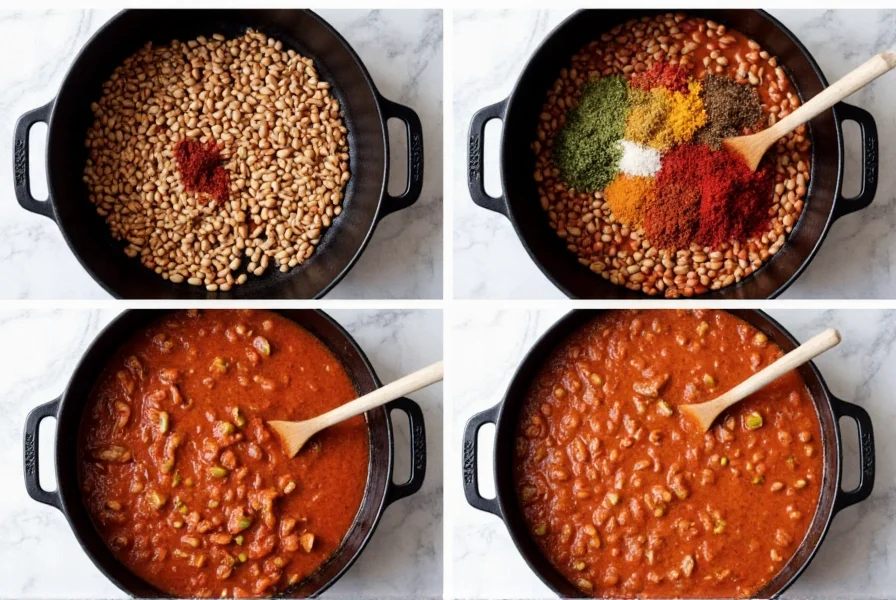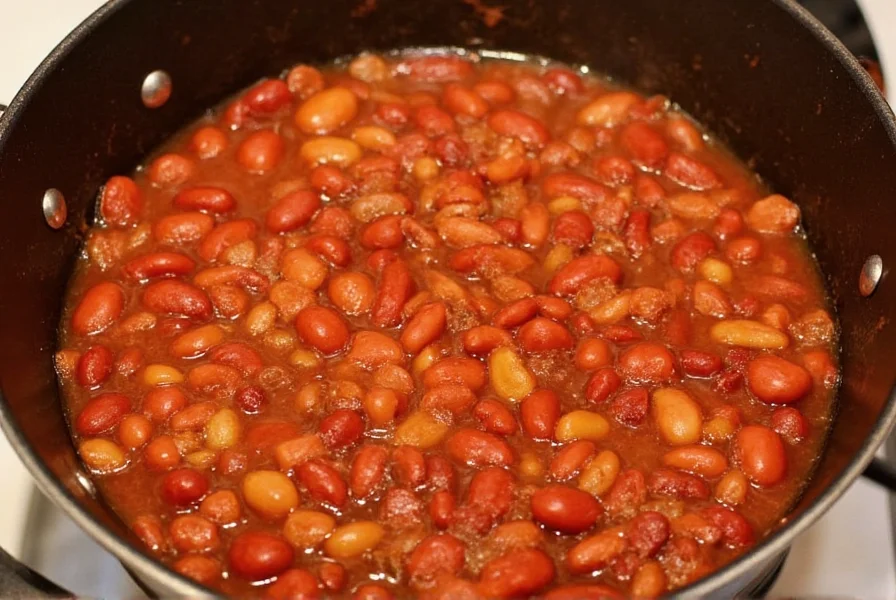Making chili beans from scratch transforms simple pantry staples into a hearty, flavorful dish that satisfies both casual weeknight dinners and special occasions. Whether you're using dried beans or canned for convenience, understanding the fundamental techniques ensures restaurant-quality results every time. This comprehensive guide covers everything from ingredient selection to finishing touches, helping you master this beloved comfort food.
Essential Ingredients for Authentic Chili Beans
The foundation of exceptional chili beans lies in quality ingredients. For traditional chili beans, you'll need:
- 1 pound dried pinto beans or kidney beans (or 3 cans, 15-ounce each, drained)
- 2 tablespoons olive oil or vegetable oil
- 1 large onion, finely diced
- 4 cloves garlic, minced
- 1 bell pepper, diced (any color)
- 2 jalapeños, seeds removed and finely chopped (adjust to taste)
- 28-ounce can crushed tomatoes
- 2 tablespoons chili powder
- 1 tablespoon cumin
- 1 teaspoon smoked paprika
- 1 teaspoon oregano
- 1 bay leaf
- 3 cups broth or water
- Salt and black pepper to taste
For meat variations, add 1 pound ground beef, turkey, or chorizo after sautéing vegetables. Vegetarian versions shine with additional mushrooms or textured vegetable protein for meaty texture.

Equipment Checklist for Perfect Chili Beans
While you can make chili beans with basic kitchen tools, these items ensure optimal results:
- Large heavy-bottomed pot or Dutch oven (essential for even heat distribution)
- Wooden spoon for stirring
- Sharp chef's knife and cutting board
- Measuring cups and spoons
- Colander for rinsing beans
- Ladle for serving
Step-by-Step Preparation Guide
Follow these detailed instructions for foolproof chili beans every time:
- Prepare beans: If using dried beans, soak overnight in plenty of cold water. Drain and rinse before cooking. Canned beans require only rinsing to reduce sodium.
- Sauté aromatics: Heat oil over medium heat. Add onions, bell pepper, and jalapeños. Cook until softened (8-10 minutes). Add garlic during the last minute.
- Bloom spices: Stir in chili powder, cumin, smoked paprika, and oregano. Cook for 1 minute until fragrant.
- Combine ingredients: Add beans, crushed tomatoes, broth, bay leaf, salt, and pepper. Stir well to combine.
- Simmer gently: Bring to a boil, then reduce heat to low. Cover partially and simmer for 90 minutes to 2 hours, stirring occasionally.
- Adjust consistency: If too thick, add more broth. If too thin, simmer uncovered for additional 15-20 minutes.
- Final seasoning: Remove bay leaf. Taste and adjust salt, pepper, and spices as needed.
Cooking Time and Temperature Guidelines
Proper temperature control ensures your chili beans develop maximum flavor without burning:
| Bean Type | Simmering Time | Temperature | Texture Indicator |
|---|---|---|---|
| Dried pinto beans | 90-120 minutes | Low simmer (180-200°F) | Creamy but intact |
| Dried kidney beans | 100-130 minutes | Low simmer (180-200°F) | Firm but tender |
| Canned beans | 30-45 minutes | Gentle heat (160-180°F) | Heated through |
Never boil chili beans vigorously, as this breaks down beans too quickly, resulting in mushy texture. The ideal simmer shows small bubbles breaking the surface occasionally.
Popular Variations to Customize Your Chili Beans
Once you've mastered the basic recipe, experiment with these authentic variations:
- Texas-style: Omit tomatoes and use only meat (typically beef), beans, and chili spices for a thicker, meat-forward version
- Vegetarian perfection: Add 1 cup corn and 1 diced zucchini during the last 30 minutes of cooking
- Smoky depth: Include 2 chipotle peppers in adobo sauce and 1 teaspoon liquid smoke
- White bean chili: Substitute cannellini beans and use green chilies instead of traditional red
- Instant Pot method: Cook soaked dried beans on high pressure for 25 minutes with natural release

Troubleshooting Common Chili Bean Problems
Even experienced cooks encounter issues when making chili beans. Here's how to fix them:
- Beans won't soften: Hard water or old beans may be the culprit. Add 1/4 teaspoon baking soda to the cooking liquid or ensure beans are fresh (less than 1 year old).
- Too spicy: Add acidity with lime juice or tomato paste, or dairy with a dollop of sour cream when serving.
- Bland flavor: Layer spices properly - sauté dried spices before adding liquids to bloom their flavors.
- Mushy beans: Overcooking or vigorous boiling breaks down beans. Simmer gently and add canned beans later in the process.
- Too thin: Mash some beans against the pot side or create a cornstarch slurry (1 tablespoon cornstarch mixed with 2 tablespoons cold water).
Serving and Storage Recommendations
Chili beans taste best when served properly and stored correctly:
- Serving temperature: Serve hot (165°F minimum) for optimal flavor release
- Traditional toppings: Offer shredded cheese, sour cream, diced onions, cilantro, and lime wedges
- Perfect pairings: Cornbread, rice, or tortilla chips complement chili beans beautifully
- Refrigeration: Store in airtight container for up to 5 days
- Freezing: Freeze portions for up to 3 months; thaw overnight in refrigerator before reheating
- Reheating: Warm gently over medium-low heat, adding small amounts of broth if needed
Interestingly, chili beans often taste better the next day as flavors continue to meld. For best results, make your chili beans one day ahead of serving when possible.
Frequently Asked Questions
Can I make chili beans without soaking dried beans overnight?
Yes, use the quick-soak method: Cover beans with water, bring to boil for 2 minutes, then remove from heat, cover, and let sit for 1 hour. Drain and proceed with recipe. Note that cooking time may increase by 20-30 minutes compared to overnight soaking.
How can I thicken my chili beans if they're too watery?
Create a slurry with 1 tablespoon cornstarch mixed with 2 tablespoons cold water, then stir into simmering chili. Alternatively, mash some beans against the pot side with a wooden spoon, or simmer uncovered for 15-20 minutes to reduce liquid naturally.
What's the difference between chili beans and regular chili?
Chili beans specifically highlight beans as the main ingredient, while traditional chili may contain little or no beans. Authentic Texas chili often contains no beans at all, focusing solely on meat and chili spices. Chili beans typically have a thicker, bean-forward texture compared to meat-centric chili recipes.
Can I use canned beans instead of dried for making chili beans?
Absolutely. Use 3 cans (15 ounces each) of drained and rinsed beans. Reduce cooking time to 30-45 minutes since canned beans are already cooked. Add them during the last 20 minutes of cooking to prevent them from becoming too soft. Rinse thoroughly to reduce sodium content by up to 40%.
How do I make my chili beans less spicy without losing flavor?
Add acidity with 1-2 tablespoons of lime juice or tomato paste, which balances heat without diluting flavor. Dairy elements like a dollop of sour cream when serving also counteract spiciness. For future batches, reduce the amount of chili powder and jalapeños, and consider removing seeds and membranes from peppers before adding them to the pot.











 浙公网安备
33010002000092号
浙公网安备
33010002000092号 浙B2-20120091-4
浙B2-20120091-4